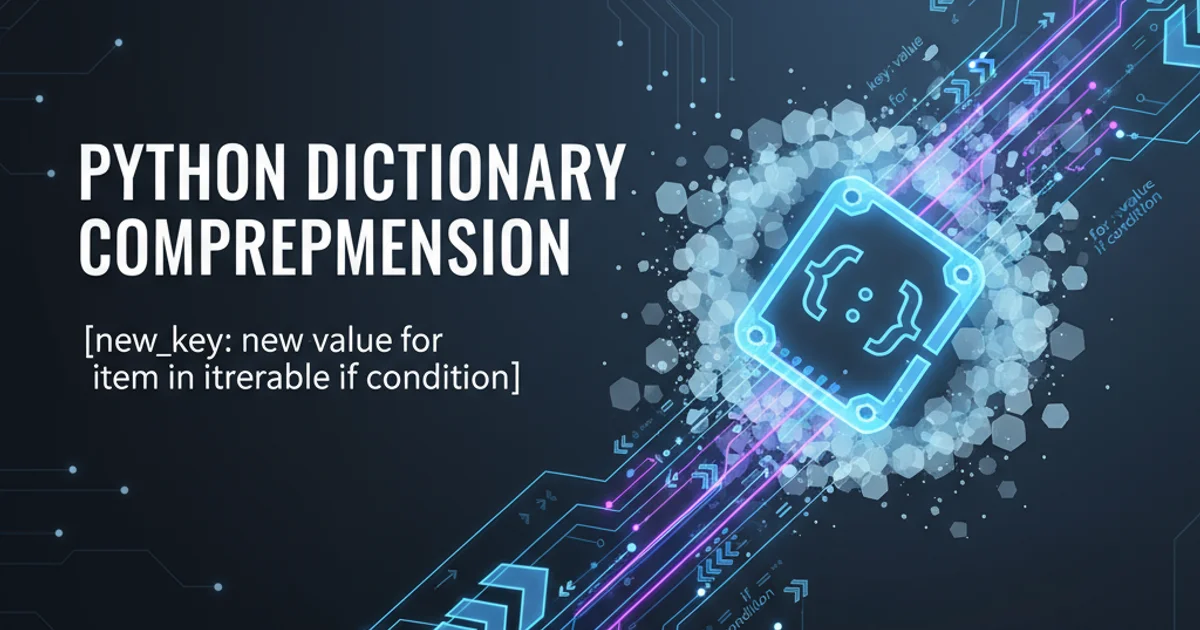Python Dictionary Comprehension
Categories:
Mastering Python Dictionary Comprehension

Unlock the power of concise and efficient dictionary creation in Python using dictionary comprehensions. This guide covers syntax, common use cases, and advanced techniques.
Python dictionary comprehensions provide a powerful and elegant way to create dictionaries. Similar to list comprehensions, they offer a more readable and often more efficient alternative to traditional for loops for constructing dictionaries. This article will guide you through the fundamentals, practical applications, and advanced features of dictionary comprehensions, helping you write cleaner and more Pythonic code.
Understanding the Basics of Dictionary Comprehension
At its core, a dictionary comprehension consists of an expression followed by a for clause, and then zero or more for or if clauses. The result is a new dictionary where each element is the result of the expression. The basic syntax is {key_expression: value_expression for item in iterable}.
# Basic dictionary comprehension
numbers = [1, 2, 3, 4, 5]
squared_dict = {num: num**2 for num in numbers}
print(squared_dict)
# Output: {1: 1, 2: 4, 3: 9, 4: 16, 5: 25}
A simple example demonstrating how to square numbers and store them in a dictionary using comprehension.
flowchart TD
A[Start]
A --> B{Define Iterable (e.g., list of numbers)}
B --> C["Loop through 'item' in iterable"]
C --> D{Apply 'key_expression' to item}
C --> E{Apply 'value_expression' to item}
D & E --> F["Create key-value pair {key: value}"]
F --> G["Add pair to new dictionary"]
G -- If more items --> C
G -- No more items --> H[End: New Dictionary Created]Flowchart illustrating the process of a basic dictionary comprehension.
Conditional Logic and Nested Comprehensions
Dictionary comprehensions can incorporate conditional logic using if clauses, allowing you to filter elements before they are added to the dictionary. You can also use if-else expressions for conditional value assignment. For more complex scenarios, nested dictionary comprehensions are possible, though they can sometimes reduce readability if overused.
# Dictionary comprehension with an 'if' condition
words = ['apple', 'banana', 'cherry', 'date']
word_lengths = {word: len(word) for word in words if len(word) > 5}
print(word_lengths)
# Output: {'banana': 6, 'cherry': 6}
# Dictionary comprehension with 'if-else' expression
status_codes = [200, 404, 500, 201]
message_map = {code: 'Success' if code < 400 else 'Error' for code in status_codes}
print(message_map)
# Output: {200: 'Success', 404: 'Error', 500: 'Error', 201: 'Success'}
Examples demonstrating conditional filtering and value assignment within dictionary comprehensions.
for loop might be more appropriate for clarity and maintainability.Practical Use Cases and Advanced Techniques
Dictionary comprehensions are incredibly versatile. They are commonly used for tasks like transforming lists into dictionaries, inverting dictionaries, or creating dictionaries from two separate lists (keys and values) using zip(). They can also be combined with other built-in functions for more advanced data manipulation.
# Creating a dictionary from two lists using zip()
keys = ['name', 'age', 'city']
values = ['Alice', 30, 'New York']
person_dict = {k: v for k, v in zip(keys, values)}
print(person_dict)
# Output: {'name': 'Alice', 'age': 30, 'city': 'New York'}
# Inverting a dictionary (keys become values, values become keys)
original_dict = {'a': 1, 'b': 2, 'c': 3}
inverted_dict = {v: k for k, v in original_dict.items()}
print(inverted_dict)
# Output: {1: 'a', 2: 'b', 3: 'c'}
Advanced examples showing dictionary creation from paired lists and dictionary inversion.